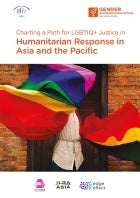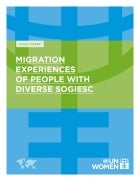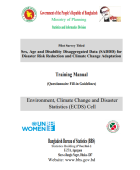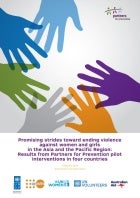1 - 19 of 19 Results
Date:
As in other regions, LGBTIQ+ communities in Asia and the Pacific are vulnerable to various forms of discrimination and violence, which are both similar to and distinct from other individuals and groups in humanitarian emergencies. These vulnerabilities stem from pre-existing inequalities, discrimination, and violence that are frequently exacerbated during crises, and are shaped by multiple intersecting factors.
Date:
UN Women is closely examining the opportunities and challenges for lesbian, gay, bisexual, transgender, gender diverse, intersex, and queer (LGBTIQ+) persons’ full equality and inclusion in electoral processes in 2024 and beyond.
Date:
This submission on electoral participation and sexual orientation and gender identity closely examines the opportunities and challenges for lesbian, gay, bisexual, transgender, gender diverse, intersex, and queer (LGBTIQ+) persons’ full equality and inclusion in electoral processes.
Date:
This toolkit—developed by the Women’s Refugee Commission (WRC) with UN Women—is a comprehensive resource to enhance the capacity of frontline humanitarian workers to integrate protection and support for adolescent boys and male youth (ABMY), including persons with diverse sexual orientation, gender identity, gender expression, and sex characteristics (SOGIESC), into protection programs.
Date:
Lesbian, gay, bisexual, transgender, intersex and queer (LGBTIQ+) people face unique and specific risks at all stages of migration. Their experiences of migration are distinct from other migrants due to the multiple and intersecting forms of discrimination they may face, especially owing to their diverse sexual orientations, gender identities and expressions, and sex characteristics (SOGIESC).
Date:
The resource guide provides key terminology and definitions, an executive summary, key messages, and a framework centred around the key principles of inclusivity, intersectionality, specificity and evidence. It also looks at how to operationalize LGBTIQ+ rights work, and shares examples and case studies of UN Women’s activities in a diversity of locations.
Date:
The study could also open avenues for further research and advocacy on various dimensions of LGBTIQ+ experiences not covered by the study.
Date:
Ending discrimination and exclusion is core to the 2030 Agenda for Sustainable Development and Leaving No One Behind. Now is the time to make a conscious choice for better representation. Read the updated checklist on how to make your panels and events diverse and inclusive.
Date:
This study was conducted as part of the Safe and Fair Programme: Realizing women migrant workers’ rights and opportunities in the ASEAN region (2018–2022). Safe and Fair is part of the multi-year EU-UN Spotlight Initiative to Eliminate Violence Against Women and Girls, funded by the European Union, and is implemented by ILO and UN Women in collaboration with UNODC.
Date:
This enumerator’s training manual was developed by the Bangladesh Bureau of Statistics (BBS), the implementation partner of the EmPower project in Bangladesh for SADDD collection, to support the rollout of the survey.
Date:
UN Women and IOM in Cox’s Bazar partnered to conduct this research which presents a critical exploration of gendered social norms among the Rohingya community in Cox’s Bazar and concludes with key reflections and guiding questions for practitioners working in response interventions in Cox’s Bazar to improve programmes with respect to sensitivity surrounding social norms.
Date:
The Asia and the Pacific region is more vulnerable to disaster impacts than any other region in the world, and is home to multiple complex emergencies and protracted humanitarian crises. The vulnerabilities of marginalized people are often exacerbated in disasters, emergencies and crises. There is a growing literature that demonstrates that this is the case for people of diverse sexual orientation identity and expression, and sex characteristics (SOGIESC),with impacts during preparedness...
Date:
An internal reference group, which includes regional and country offices, provided comments and inputs. An informal reference group of partners on LGBTI issues, convened by the Policy and Civil Society Divisions, also provided expert advice and support during the drafting. The Policy Division and Civil Society Division is grateful to all contributors to this work.
Date:
This report provides insights for donors, policymakers, programme managers, and practitioners into the development, implementation, and evaluation of primary prevention interventions designed to prevent violence against women and girls (VAWG).
Date:
This is the sixth compilation of good practices on integrating gender into humanitarian action in Asia, developed on behalf of the Regional Network Working Group on Gender in Humanitarian Action in Asia-Pacific.Despite recent strides towards ensuring the safety and enjoyment of equal rights by LGBTIQ+ persons in the Asia-Pacific region, persistent and sizeable obstacles to inclusion remain, including harmful legal frameworks and religious, cultural, and societal stigmas which, when combined...
Date:
The transgender (TG) community is one of the most marginalized social groups in India. Historically subjected to structural violence, the TG community continues to face widespread stigma and discrimination at the hands of their own families, society and even the state. Despite some recent progressive measures by the government, the community’s social mainstreaming and access to rights and entitlements remains shrouded in challenges. 'The Transgender Question in India: Policy and Budgetary...
Date:
This paper highlights the unique discriminations and exclusions lesbians, bisexual women, transgender and intersex persons (LBTI) face across the region as well as the challenging issue that gender and sexual diversity remains based on the proceedings of the 2016 Regional Consultation on Promoting and Protecting the Rights of Lesbians, Bisexual women, Transgender and Despite changes in national legislations and policies, such as the abolition of a ban on same-sex marriages...
Date:
A situation Report on ''Nepali women in the Middle East-2013'' has been jointly published by Nepal Institute of Development Studies and Non Resident Nepalese Association with support of UN Women and European Commission. The study has extracted the factors and facts related to women migrant workers. The study has been conducted in the four major destinations of women migrant workers namely Saudi Arabia, Kuwait, UAE and Lebanon. The report shows that currently 1,174,154 women migrant workers are...
Date:
This report tracks the progress made by women in South Asia in areas such as violence against women, and economic empowerment. This was the base document for the Seventh South Asia Regional Ministerial Conference in October 2010.



![[cover]](/sites/default/files/styles/search_image_140px/public/2024-06/hq-cx-at-risk-of-sexual-exploitation-en-960px.jpg?itok=YBrY3TwO)

![[cover]](/sites/default/files/styles/search_image_140px/public/2023-06/ap-LGBTIQ%2BINTERNAL-RESOURCE-GUIDE-960px.jpg?itok=DiAK2WED)
![[cover]](/sites/default/files/styles/search_image_140px/public/2023-06/np-LGBTIQ-Study-Report-11June-English-1.jpg?itok=j8h-io1u)
![[cover]](/sites/default/files/styles/search_image_140px/public/2023-03/bd-Diversity-in-Dialogue-II-new-2023-960px.jpg?itok=Lzxmk8Mq)
![[cover]](/sites/default/files/styles/search_image_140px/public/2022-09/ap-SOGIE-Study_FINAL-960px.jpg?itok=k2VdiSMZ)



![[cover]](/sites/default/files/styles/search_image_140px/public/2023-06/ap-Internal-Guidance-Note-on-LGBTI-Programming-and-Advocacy-960px.jpg?itok=FaEGvA9R)





